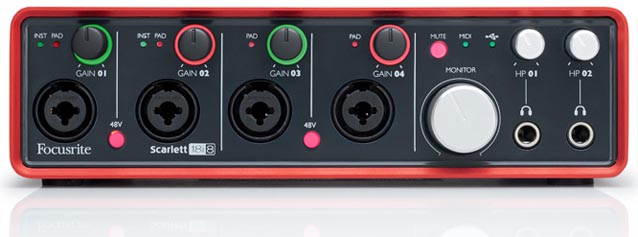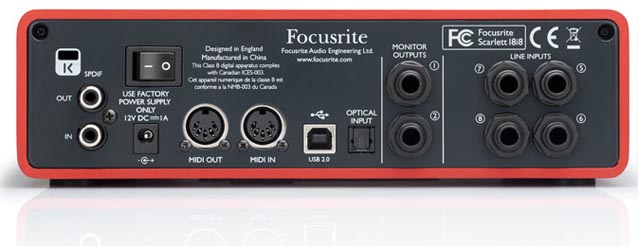In the world of abundance of USB2 sound interfaces it can be rather challenging to find the unit that fits your needs. With that in mind we took a look at the newly introduced Scarlett 18i8 up close. The interface is another addition to the rather successful Scarlett series. The previous Scarlett series were more like the starter series of USB interfaces. Focusrite now is extending this with new models that have more ins and outs. The 18i8 in that regard seems to be aimed at the mid-range.

Multiple INs and OUTs
Personally I am not very fond of the abundance of the above mentioned ins and outs, so I’ll break it down. This interface basically has 8 analog inputs, adat in, midi in/out, spdif in/out, 2 main outputs and 2 headphone outputs. 4 of the analog inputs have phantom power (switchable in pairs) and 2 of those 4 have hi-Z inputs.
To me this implies this interface is more aimed at recording, live venues rather than outboard mixing. Applications could be home studio with 2, 3 or 4 people recording. Live venues with a laptop or band rehearsals, when you get an Adat expansion for the 8 extra inputs for the drum mics. Mind you that if you would prefer the Focusrite Octopre expansion, for consistency in the sound with this audio interface, you can only use the inputs with the 18i8.
Built
The unit itself comes in a very sturdy metal casing that should be able to stand a good few bounces on the concrete floor I reckon. The buttons and knobs do feel nice. The mute button has a small fade in/out functionality which your speakers will appreciate. Too bad the activation of the hi-Z inputs are software controlled though. Same goes for the ADAT input that cannot be used as an extra optical spdif input. The two headset outputs have separate level knobs. The front has little lights so you won’t have this Christmas lighting effect, when used in darker environments. The backside layout is just as straightforward. The screws at the back are sinked in. The security slot for bolting the unit seems sensible, there however is a lack for a slot to secure the adapter power input which can get tugged out at the worst possible times. Should be fairly easy to tap a hole and screw on a clip if you would like to have that option.
Also at the back of the unit it’s mentioned that the electronics are Class-B which is expected. Same goes for the specification for the AD/DA’s. In this price range the difference in quality of sound is almost always neglectable. With my high-end monitors and headset I could hear it sounds as expected. I did notice though when inputs or outputs are pushed too hard the sound was becoming slightly distorted, which is fairly normal of course, but that’s something you have to keep in mind. Just make sure your inputs don’t clip and put a brickwall limiter on your master bus and you’ll be fine.

Recording
For vocalists or people who want to record acoustic instruments, the preamps are what you’d expect. Very pristine and clean without any overly excited sound. Not the coloring kind too. If so, nowadays there are plugins which are a great help to adjust that to your liking. Speaking of plugins. Included is the Scarlett plug-in suite. But I’m going to be very harsh here are and state those plugins are an insult to the buyer. (Yes I’m a audio snob.) Even Steinberg/Ableton default plugins sound better (and that says a lot!). So as a user you’d better off using the plugins of Ableton Live Lite that comes with the interface. Or upgrade to/use a DAW of your personal preference.
Midi can be used to hook up a controller or synth. Or even a few synths in a midi-thru loop since you can use 4 line ins for instruments. Nowadays most new synths and controllers come with USB port so it depends if you would use it at all. Personally I prefer to use the USB port of the synth/controller. However, in this case it’s nice to have the option.
As to installing the drivers. That was simply the case of downloading them from the Focusrite website, installing them and plug in the USB cable. Default, the latency is configured at 10ms. On my i7 PC I could turn that down to 3ms, which is decent for an USB audio interface. So you’ll most likely won’t have to use the 0-latency recording option imbedded into the Mixcontrol. I didn’t do a lengthy test but word out there is that Scarlett drivers are good. As to the drivers themselves there seems to be no iOS/Android support. Since this unit is very suitable for recording I think that’s a shame, as the tablet market is rather huge. Maybe Focusrite will address this in the future.
Mixcontrol
The Mixcontrol is the central place to adjust anything. When using the interface for playback you cannot change the sampling rate though. The mixing itself is a matrix where you can mix all inputs (including 8 DAW inputs) to 8 busses and route them to the outputs. For example to create sub mixes for singers/instrumentalists. Or even create a 8 input ADAT sub mix and route that to the spdif out on the side next to your normal inputs and outputs. You can even save those settings to the hardware itself so it works without being connected via USB. At the bottom of the Mixcontrol you can adjust the 4 analog front inputs to line/hi-Z and just pad. There seems to be a bug that the pad adjusting doesn’t show up in Mixcontrol but does on the unit itself. Additionally on a larger screen the application tends to turn out a bit small, scaling capabilities would have been nice, I think.
Also included are the Novation Bass Station plug-in and 1Gb of Loopmasters samples. Nice to get free stuff but on the other hand, I think most users would prefer a lower cost price, as the competition is quite hard in this price range. That’s also my main reason for the nitpicking here. That said, Focusrite presents a good sounding unit that is small enough to “schlep” around for live gigs and yet has enough inputs to enable recording a small group of people, and with an additional Adat AD a small band, without the need of a small mixer. Again the Focusrite 18i8 is a good mid-range interface with a nice set of features.
